| Time (Hrs) | Topics | Description |
|---|---|---|
| 08.30 - 9.30 | Brief introduction to notation and some preliminary concepts including charge as a fundamental source of EM fields: Prof. Prabhakar Pathak, OSU, USA |
|
| 9.30 -10.30 | Development of EM Reciprocity and Reaction Theorems for Antennas in the frequency domain: Prof. Prabhakar Pathak, OSU, USA |
|
| 10.30 -11.00 | Tea Break | |
| 11.00-12.00 | Additional applications of generalized reciprocity/reaction theorems: Prof. Prabhakar Pathak, OSU, USA |
|
| 12.00-13.00 | Slotted rectangular waveguide array analysis: Prof. Prabhakar Pathak, OSU, USA |
|
| 13.00 -14.00 | Lunch Break | |
| 14.00-15.00 | Electrification - What the future holds for an EMC Engineer? Dr. Vignesh Rajamani, President (2022-2023), IEEE Electromagnetic Compatibility Society |
Energy is central to nearly every major challenge and opportunity the world faces today, and countries are racing to help mitigate climate change and invest in energy models that are not only clean but sustainable. The transformation of transportation by using batteries as form of energy source is transformative and disruptive, if not existential. The engineering challenges that come along with electrification is huge and the opportunities are even bigger. Making electric components that can operate efficiently while handling the higher voltages and currents and protecting them against Electromagnetic Interference both from the external and internal electromagnetic environment guarantees a bright future for Electromagnetic Compatibility Engineers around the world. This talk will discuss some challenges and most importantly the opportunities that exist in the field of EMI/C when it comes to the future of e-mobility and electrified transportation. |
| 15.00-16.00 | Constructive Parameters of Metamaterial: Lorentz Versus Floquet Models : Arun K. Bhattacharyya, Fellow IEEE, Center of Excellence, Lockheed Martin Space, Littleton, Colorado, USA. |
An array of conducting obstacles in a host dielectric medium modifies the constructive parameters of the composite medium. Typically, the parameters are estimated using Lorentz model. The Lorentz model predicts that an array of metallic obstacles modifies both permeability and permittivity tensors. Recently, a rigorous Floquet eigenmodal formulation was developed to analyze metamaterials. Contrary to the Lorentz model, the Floquet model predicts that the perfectly conducting obstacles modify the permittivity tensor, but do not modify the permeability tensor of the metamaterial. Interestingly, numerical results obtained from two independent full wave analyses of metamaterial-slabs support the Floquet model. In this presentation, we describe both models and examine the source of discrepancy between the models. We also discuss whether a metamaterial with negative permeability is achievable using conducting obstacles. |
| 16.00 -16.30 | Tea Break | |
| 16.30-17.30 | Chipless RFID, IoT, and 5G and Beyond Technologies for the 21st Century: Dr. Nemai Chandra Karmakar, Director, Monash Microwave, Antenna, RFID and Sensor Laboratory (MMARS), Director, ECSE Industry Engagement, Monash University, Australia |
The post-COVID-19 21st -century era has witnessed tremendous impetus in low latency high data rate wireless communications. When people were in lockdowns, the vital means for wireless communications with video content are smartphones using 4/5G and beyond communications. Now, this tradition continues and becomes a new normal in society. The vital building blocks to support such high data rate mobile communications are ultrawideband and/or multiband RF/microwave/mm-wave transceivers, smart antennas, signal processing algorithms and digital design. The Internet of Things (IoT) plays a vital role in fluidity and transparency in data communications over the Internet. The backbone of IoT is radiofrequency identification (RFID) technology. Due to the application-specific integrated circuits (ASICs) in the RFID tag, the cost of the identification and tracking system has become formidably expensive for mass deployment. The chipless RFID, which is a technology in-between the RFID and optical barcodes, has wireless sensing capability and can shade new light in the IoT infrastructure. Microwave and mm-wave ultrawideband technologies are essential elements for chipless RFID readers, signal processing and encoding and decoding techniques. This special tutorial session will provide comprehensive details of the UWB microwave and mm-wave transceiver design, the multiple input multiple output (MIMO) smart antenna system, various chipless RFID tags and signal processing algorithms. Along with this, the 5G and beyond technologies, augmented with monolithic microwave integrated circuits (MMIC) GaAs and GAN-based phase shifters and switching elements, have accelerate the high data rate wireless communications. This tutorial presents these cutting edge technologies automation in mining, manufacturing, healthcare, border security and customs, government departments, retail and many more industries. |
